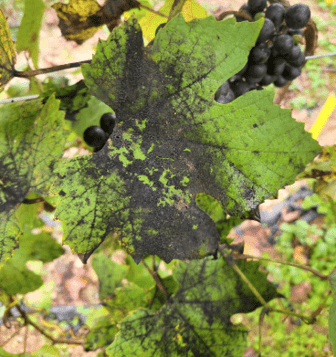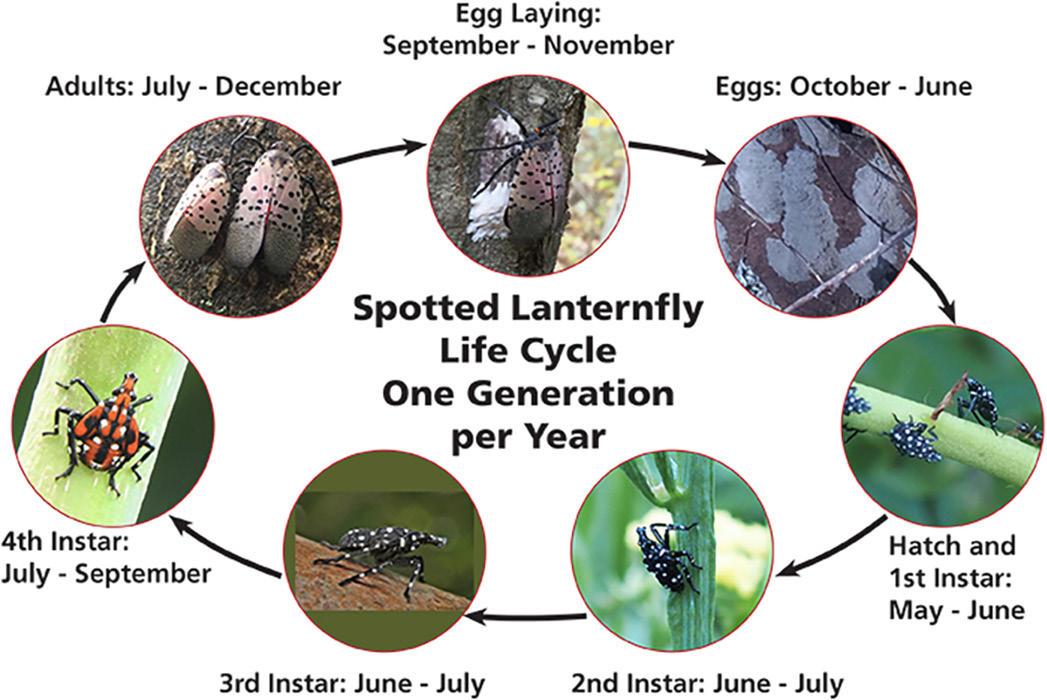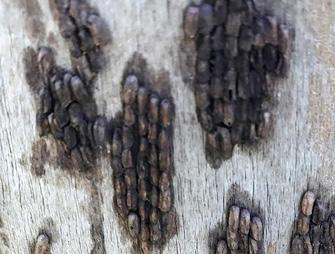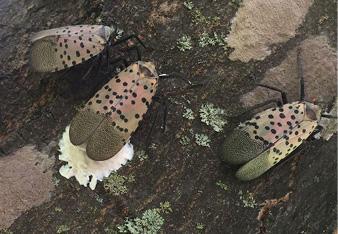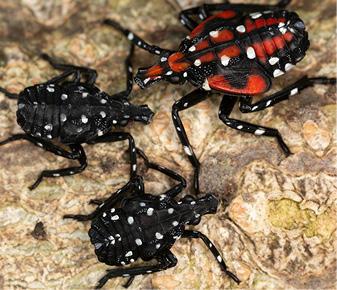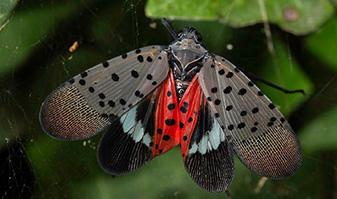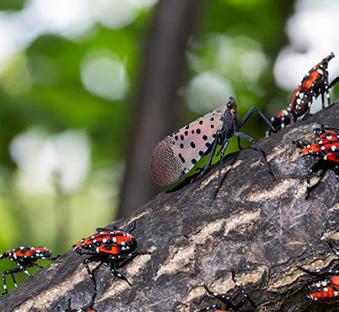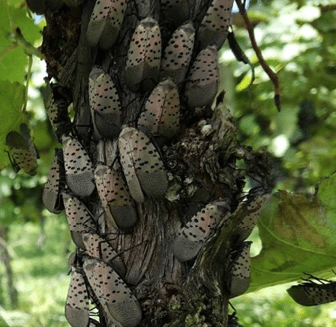Key points of this publication
The goal of this publication is to enable affected industries to be proactive in reducing the spread of spotted lanternfly (Lycorma delicatula, Hemiptera: Fulgoridae). We present information on spotted lanternfly identification, life cycle, host plants and current known methods of control.
- Spotted lanternfly produces honeydew that promotes fungal growth on leaves, reducing photosynthesis. Feeding can cause dieback and plant death.
- Two dead spotted lanternfly adults were found in Willamette Valley nurseries during fall of 2020. As of January 2021, there is no known established population of spotted lanternfly in Oregon.
- Spotted lanternfly is found in at least nine U.S. Eastern states and is largely spread through human action.
- Oregon has multiple high-value industries that may be affected, including winegrapes, nursery and tree crops, small fruits and timber.
- The Oregon Department of Agriculture (ODA) must be contacted immediately when spotted lanternfly is sighted ([email protected]). For complete reporting details, see “How to collect and report spotted lanternfly” below.
Spotted lanternfly distribution in the U.S.
Spotted lanternfly is a plant hopper native to southern China, Taiwan and Vietnam. It has spread to Japan, South Korea and the U.S. Spotted lanternfly was first recorded in the U.S. in September 2014 in Berks County (Philadelphia), Pennsylvania. It is now found in Connecticut, Delaware, Maryland, New Jersey, New York, Ohio, Pennsylvania, Virginia and West Virginia.
This insect falls under state quarantine; it is not known to be established in Oregon. In the states where it is established, quarantine measures strictly prohibit the movement of any spotted lanternfly living stage, including egg masses, nymphs and adults, and mandate inspection of articles that may harbor the insect before they can be moved.
Host range and plant symptoms
Spotted lanternfly has a broad range of plant hosts, including grape, stone fruits, apple, ornamental species, maple, black walnut, willow and rose. Nymphs and adults are phloem feeders. They suck sap from young stems and leaves, which can cause wilting and plant stress. High numbers of spotted lanternfly can reduce photosynthesis, weaken the plant and eventually contribute to the host plant’s death.
Feeding can cause the plant to weep or ooze, resulting in fermented sap. The weeping wounds leave a grayish-black trail along the trunk. The insect also secretes large amounts of honeydew, which, together with the wounds, promote the growth of sooty mold (Figure 1). Sooty mold can coat leaf surfaces and fruits, interfere with photosynthesis and reduce plant growth and fruit quality. Honeydew secretion often attracts other insects such as yellow jackets, hornets, bees, ants and flies.
Life cycle
Spotted lanternfly produces one generation per year, overwintering as egg masses. It develops through four nymphal stages before reaching the adult stage (Figure 2, page 2). In the mid-Atlantic region, eggs hatch in spring; first instar nymphs appear May through June. Adults appear July through December. Mating begins in late August, and eggs are laid September through November or until the first killing freeze.
Spotted lanternfly travels on suspect materials
Egg masses are the most likely pathway for the spread of spotted lanternfly (Figure 3, page 3). For the untrained eye, they are difficult to find. The materials in the following list are ordered from high to low likelihood as means of spreading spotted lanternfly:
- Known woody host plants with a diameter greater than one-third inch.
- Woody plants with a diameter greater than one-quarter inch.
- Roundwood and sawn wood.
- Wood packaging material such as crates, pallets or dunnage.
- Items such as pots or trellis systems.
- Wood chips and processed wood residues (except sawdust and shavings).
- Bark pieces larger than 1x1 inch.
Materials originating from known infested areas present a higher risk.
Identify spotted lanternfly
Eggs are the life stage most likely to be distributed by humans and the most difficult to see. Females lay at least two egg masses of 30–60 eggs laid in rows (Figure 3). Egg clusters are covered with a creamy white, puttylike substance that becomes gray as it dries (Figure 4). With time, the covering turns tan and begins to crack, resembling a splotch of mud. Old egg masses appear as rows of 30–60 brownish seedlike deposits in 4–7 columns, measuring roughly 11⁄2 inch in length.
Egg masses are laid on any hard or smooth surface, such as trees, under bark or on rusty metal, plastic yard objects, cars and trailers, outdoor grills, cushions, pallets, stone and many other outdoor surfaces. Egg masses can be well camouflaged, depending on the surface on which they are laid. See the sidebar “Spotted lanternfly travels on suspect materials” (page 5).
The bodies of the first three nymph instars are black; legs and the abdomen have white spots. Generally, the first instar nymph is nearly one-fifth inch long (Figure 5). Second and third instar nymphs are about one-quarter and one-third inch long, respectively.
The fourth-instar nymph is up to three-quarters inch in length and has red coloration (Figure 5). Fourth-instar nymphs molt and become adults that measure approximately 1 inch in length.
Adults of both sexes superficially resemble a moth, with which they are often confused due to their strikingly colored hind wing and size (Figure 6). Adult spotted lanternfly have a wider abdomen than the typical moth, and they often hold their wings folded over their backs rather than extended. The wings are usually folded when the insect is at rest on a trunk or plant materials (Figures 7 and 8, page 4).
Often, the male and female can be distinguished by size. Spotted lanternfly females are 0.8–1 inch in length from head to the end of the folded wing; males are slightly smaller. The underside of the last segment of a female’s abdomen is red, whereas on a male it is black.
Head and legs of both sexes are dark brown to black. The unusual short antennae are bulbous, orange and have needlelike tips. Forewings are grayish with black spots; hind wings are banded black and white at the anterior and deep red at the posterior. Tips of the wings show a network of veins. The abdomen is yellowish with incomplete black bands. Leg length is approximately two-thirds inch.
How to collect and report spotted lanternfly
Early reports of spotted lanternfly detection are crucial to limiting its spread and the damage it causes. Collect suspected spotted lanternfly insects or egg casings and immediately report to the Oregon Department of Agriculture pest reporting portal ([email protected]).
Place the insect or egg case into a container of alcohol to kill and preserve it. Egg cases may be placed in a self-sealing plastic bag and killed with hand sanitizer.
Record the following information when reporting spotted lanternfly findings:
- Date, collector’s name and telephone number.
- Surface of finding (for example, species of tree or, for an egg case, the structure on which it was found).
- Collection location, including state, county, address or nearest intersection and GPS coordinates, if available.
Chemical control
At this time, chemical insecticides are the most effective way to control spotted lanternfly. No pesticides have been registered with the state of Oregon for spotted lanternfly. Insecticides are to be used once spotted lanternfly is present; they are not a preventative. Pesticides will become available should spotted lanternfly establish in Oregon. It is essential that you read the label and product insert warnings carefully when using any pesticide. It is a violation of federal law to use a pesticide in a manner other than as directed by the label. Contact your local Extension agent or crop consultant for more information about spotted lanternfly management.
Conclusion
Spotted lanternfly poses a significant economic risk to agriculture and timber industries in Oregon. Early detection is the key to preventing spotted lanternfly from becoming established in Oregon. Report spotted lanternfly when you see them and work with state agencies to limit infestation and spread throughout Oregon.
Useful Web resources
- Pennsylvania State University Spotted Lanternfly Information
- Pennsylvania Department of Agriculture Spotted Lanternfly Alert
- USDA National Invasive Species Information Center Spotted Lanternfly Information
- USDA Animal and Plant Health Inspection Service Spotted Lanternfly Information
References
- Barringer, L. and C. Ciafré. 2020. Worldwide feeding host plants of spotted lanternfly, with significant additions from North America. Environmental Entomology 49:999–1011.
- Dara, S., L. Barringer and S. Arthurs. 2015. Lycorma delicatula (Hemiptera: Fulgoridae): A new invasive pest in the United States. Journal of Integrated Pest Management 6.
- Frantsevich, L., A. Ji, Z. Dai, J. Wang, L. Frantsevich and S. Gorb. 2008. Adhesive properties of the arolium of a lantern-fly, Lycorma delicatula (Auchenorrhyncha, Fulgoridae). Journal of Insect Physiology 54:818–827. doi.org/10.1016/j.jinsphys.2008.03.005
- Han, J., H. Kim, E. Lim, S. Lee, Y.-J. Kwon and S. Cho. 2008. Lycorma delicatula (Hemiptera: Auchenorrhyncha: Fulgoridae: Aphaeninae) finally, but suddenly arrived in Korea. Entomological Research 38:281–286.
- Keller, J., J. Rost, K. Hoover, J. Urban, H. Leach, M. Porras, B. Walsh, M. Bosold and D. Calvin. 2020. Dispersion patterns and sample size estimates for egg masses of spotted lanternfly (Hemiptera: Fulgoridae). Environmental Entomology 49(6):1462–1472. doi.org/10.1093/ee/nvaa107
- Leach, H., D. Biddinger, G. Krawczyk, E. Smyers and J. Urban. 2019. Evaluation of insecticides for control of the spotted lanternfly, Lycorma delicatula (Hemiptera: Fulgoridae), a new pest of fruit in the northeastern U.S. Crop Protection 124:104833.
- Liu, H. 2019. Oviposition substrate selection, egg mass characteristics, host preference, and life history of the spotted lanternfly (Hemiptera: Fulgoridae) in North America. Environmental Entomology 48:1452–1468.
- Malek, R., J. Kaser, H. Broadley, J. Gould, M. Ciolli, G. Anfora and K. Hoelmer. 2019. Footprints and ootheca of Lycorma delicatula influence host-searching and acceptance of the egg-parasitoid Anastatus orientalis. Environmental Entomology 48:1270–1276.
- Sisti, P., D. Pfeiffer and E. Day. 2018. Lycorma delicatula (White) (Hemiptera: Fulgoridae). Virginia Cooperative Extension.
- Urban, J. 2020. Perspective: Shedding light on spotted lanternfly impacts in the USA. Pest Management Science 76:10–17.


